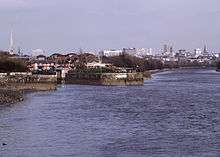River Hyndburn
The River Hyndburn is a minor river in Lancashire, England. Beginning as Woodnook Water on the slopes of Goodshaw Hill, it passes through Stone Fold, Rising Bridge and Baxenden where it is augmented by streams from Thirteen Stone Hill and continues to the Woodnook area of Accrington.[1] Near St James Church, it collects Broad Oak Water (recorded in 1800 as the River Grange), becoming the River Hyndburn.[2][3]
| Hyndburn | |
|---|---|
 River Hyndburn at Church Bridge. | |
| Location | |
| Country | England |
| Physical characteristics | |
| Source | |
| • location | Goodshaw Hill, Rossendale (as Woodnook Water). |
| Mouth | |
• location | Hyndburn Brook, south of Dunkenhalgh. |
It heads northward through the town centre, collecting Pleck Brook and turning west, as it flows under the East Lancashire railway line viaduct, it continues to Church.
Here it turns northward again, meeting Hyndburn Brook just before it passes under the M65 motorway bridge to the south of Dunkenhalgh,[4][5] which continues past Clayton-le-Moors and Great Harwood, ultimately joining the River Calder. Today, much of the course of the river and parts of its tributaries run underground through culverts.[1] The Hyndburn borough of Lancashire is named after the river.
Meaning of the river name
The name is from Old English burna "stream" (not Old Norse brunnr 'spring', as with some place names over the boundary in North Yorkshire). The first element of the name is uncertain; it may be Old English hyldre "an elder-tree", or hynd "hind", or the Old Norse/Old English personal name Helþor/Helthor.
Two streams which go on to become the River Hyndburn lie within the old township of Henheads. The township is thought to be thus named, because the Hyndburn was more often called the Henburn in the past.
Tributaries
- Antley Syke
- Pleck Brook [6]
- Broad Oak Water
- Warmden Brook
- Tag Clough
- Laund Clough
- Warmden Brook
- Woodnook Water
- Tom Dale Clough
- Luddington Clough
Wildlife
An ongoing river improvement scheme aimed to allow migrating salmon, trout and eels access to the River Hyndburn, saw the construction in 2017 of a fish bypass at the 4-metre (13 ft 1 in) high, 19th-century Oakenshaw Print Works weir on Hyndburn Brook.[7][8] In June 2019, work started on a similar project, upstream at the weir of Dunkenhalgh near Rishton.[9]
On 11 July 2018, Woodnook Vale and Peel Park were officially designated as local nature reserves, becoming the two largest in Lancashire. Woodnook Vale covers approximately 2.2 miles (3.5 km) of Woodnook Water, south of Accrington and includes Rothwell Heights on the western side of the valley. The Peel Park site, east of the town, covers the mill ponds above the old Plantation Mill print works site,[10] which supply Pleck Brook.[6]
References
| Wikimedia Commons has media related to River Hyndburn. |
- "OL21" (Map). South Pennines. 1:25,000. Explorer. Ordnance Survey. 2015. ISBN 9780319242605.
- Lancashire and Furness (Map). 1 : 2,500. County Series. Ordnance Survey. 1892.
- Crossley, Richard Shaw (2013), Accrington Through The 19th Century, lulu.com, p. 8, ISBN 978-1300775966
- Lancashire (Map). 1 : 2,500. Ordnance Survey. 1911. Sheet LXIII.10.
- "Hyndburn". Catchment Data Explorer. Environment Agency. Retrieved 5 July 2019.
- Crossley p.293
- Nic Marko (21 February 2018). "New £128k fish bypass opens to bring salmon back to River Hyndburn". Lancashire Telegraph. Retrieved 26 July 2019.
- "Brown trout have been tracked since new fish pass was put in place". Natural Course. 22 May 2019. Retrieved 26 July 2019.
- RLTWebadmin (20 June 2019). "Work commences on Dunkenhalgh Weir". Ribble Life Together. Retrieved 26 July 2019.
- "Woodnook Vale and Peel Park Local Nature Reserve leaflet". Hyndburn Borough Council. 2019. Retrieved 27 July 2019.
External links
- Images from culverted sections at substormflow.com Warmden Brook (Broad Oak Water), Confluence with Woodnook Water, Lower River Hyndburn
